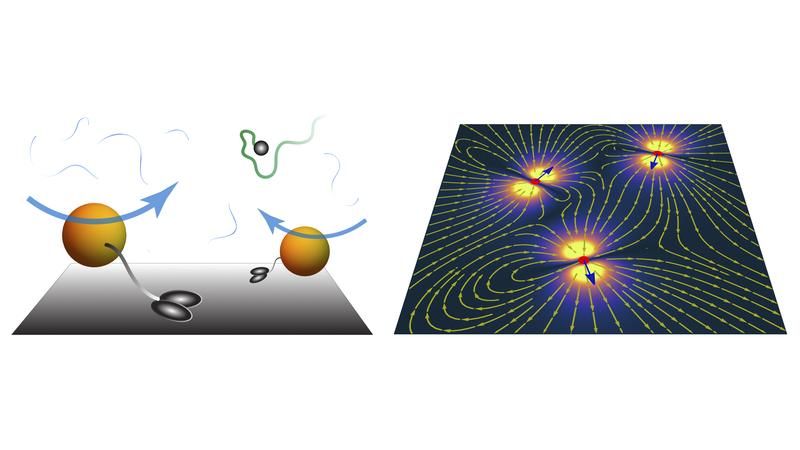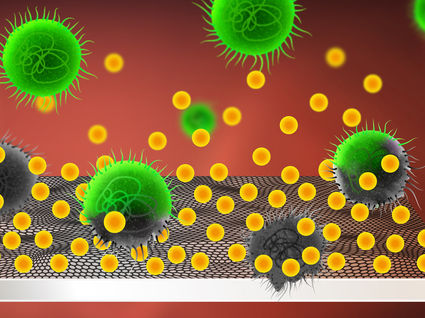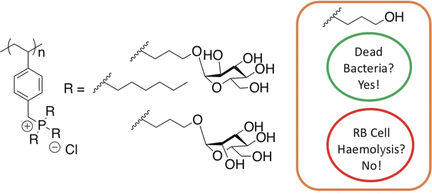Microscopic fluctuations help bacteria to do their work
Advertisement
A publication from Theoretical Physics at Heinrich Heine University Düsseldorf (HHU) with American partners provides new insights into the diffusion process in complex and living systems. This has far-reaching implications for bacterial biofilms, active coatings and even mechanisms to be able to eliminate pathogens such as Covid-19.

An active carpet of molecular motors (orange large spheres) generates strong flux fields that increase the diffusion of particles (grey small sphere).
Arnold Mathijssen
If you drop ink into a glass of still water, diffusion causes the water to slowly change color. But although it has been known for many decades how diffusion processes can be described, it is not well understood how they work in more complex systems such as living organisms.
A study offers new insights into the diffusion process of complex systems. Prof. Dr. Hartmut Löwen of the HHU Institute for Theoretical Physics II, together with Prof. Dr. Arnold Mathijssen of the University of Pennsylvania and Prof. Dr. Francisca Guzman-Lastra of the Universidad de Chile in Santiago, developed a new theoretical framework of diffusion. This has far-reaching implications for a range of systems with active surfaces, including biofilms and active coatings. Likewise, it may be possible to derive mechanisms to eliminate pathogens.
Prof. Löwen: "In principle, diffusion is described by the so-called Fick's laws. They state that particles, atoms or molecules always drift from an area of high to one of low concentration." Thus, diffusion determines the spread of small molecules in the body. However, when the particles to be transported become larger - such as proteins or cells - standard diffusion is too slow for true transport.
Such particles need active transport components. In biology, these are called "active carpets" - for example, cytoskeletal motors or cilia that add small amounts of energy to the environment to make diffusion more efficient.
Even before the corona-induced lockdown, a visit to Düsseldorf established an international collaboration between Prof. Löwen, Prof. Mathijssen and Prof. Francisca Guzman-Lastra. They wanted to understand how active motion on substrates can trigger effective solvent fluxes.
Biofilms are an important example of active carpets. They are layers of microorganisms - such as bacteria, algae or fungi - and also multicellular organisms that develop on surfaces where they form a slime layer. These films are critical, especially in medicine, because pathogens can multiply in them, which are protected from the immune system by the mucus.
Bacteria in biofilms create "currents" with their flagella or flagella that pump fluid and nutrients from their environment. But how can biofilms supply themselves if nutrients are only accessible to a limited extent? Prof. Löwen explains: "They can increase their food intake by generating currents. But this also costs energy. The key question for us was: how much energy do they put in to get how much energy out?"
To understand both bacterial dynamics and Fick's laws, the researchers developed a model similar to the so-called Stokes-Einstein equation, which describes the equilibrium relationship between temperature and diffusion. They found that microscopic fluctuations could explain the changes they saw in particle diffusion. The new model also revealed that diffusion produced by small motions is incredibly efficient, allowing bacteria to obtain a large amount of food using only a small amount of energy.
"We have now derived a theory that predicts the transport of molecules within cells or near active surfaces," said Prof. Guzman-Lastra, adding, "My dream would be to see these theories applied in different biophysical settings." Prof. Mathijssen points to the cilia in the lungs, which form the first line of defense against pathogens such as COVID-19. They are another important example of active carpets in biology: "In addition to a general experimental test, high on the agenda is whether our theory of active carpets can be linked to the elimination of pathogens in the respiratory tract.
Note: This article has been translated using a computer system without human intervention. LUMITOS offers these automatic translations to present a wider range of current news. Since this article has been translated with automatic translation, it is possible that it contains errors in vocabulary, syntax or grammar. The original article in German can be found here.




























































